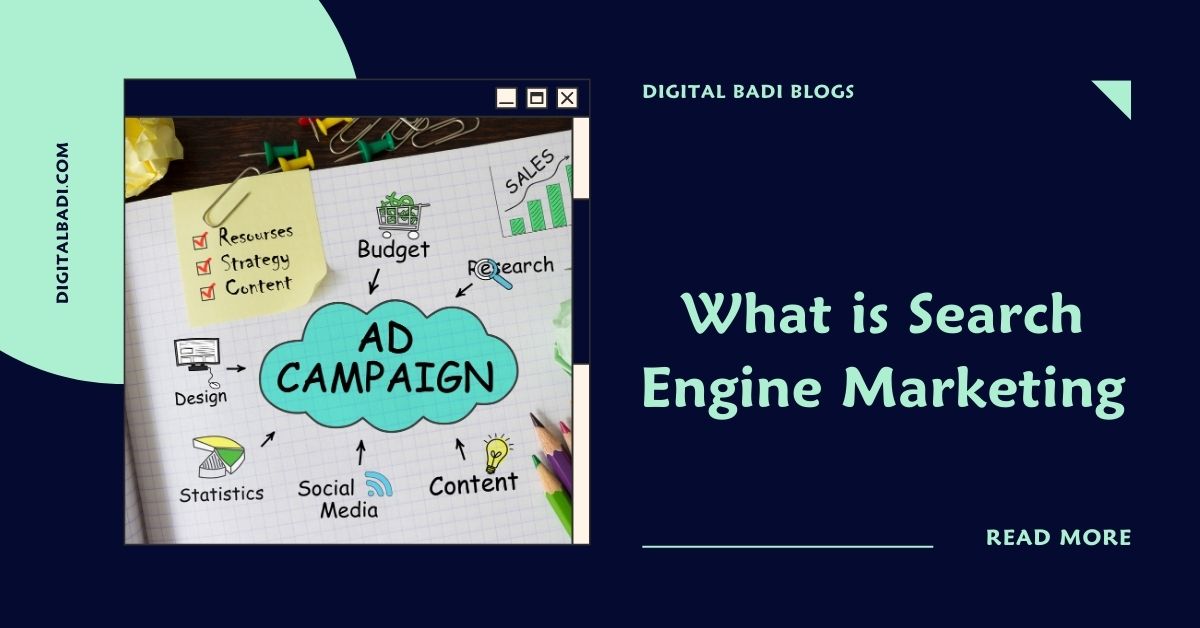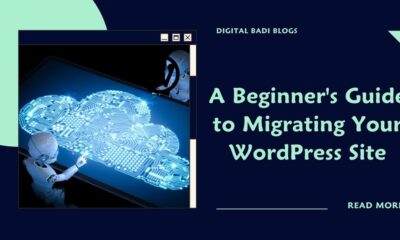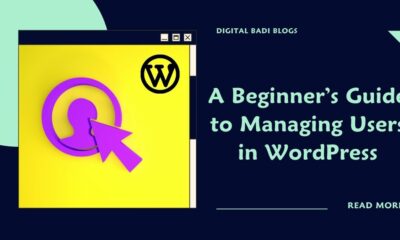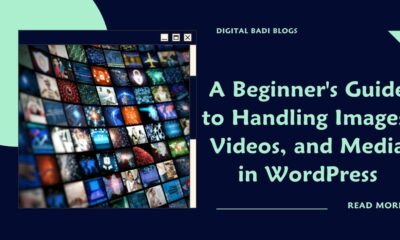Modules of Digital Marketing
What is Search Engine Marketing: A Complete Guide for Beginners

Table of Contents
What is Search Engine Marketing
Hey everyone! John here again, digital marketing expert and founder of Digital Badi. Last time we had a deep dive on SEO. Today I want to explore the ins and outs of another essential online marketing channel – search engine marketing, or SEM for short.
Search engine marketing refers to paid advertising on search engines like Google and Bing. While SEO aims to boost your visibility in organic search results, SEM focuses on paid ads that appear alongside them.
What is Search engine marketing (SEM):Is a method of promotion and advertising to help companies’ content rank higher among search engine traffic. Like search engine optimization (SEO), search engine marketing helps companies improve the way content is ranked by search engines.
SEM might sound intimidating at first, but it’s actually not so bad once you break it down! In this post, I’ll provide a beginner’s guide to SEM and how you can leverage it to drive more clicks and conversions for your business.
Let’s get into it!
A Quick Definition of Search Engine Marketing
So what exactly is SEM? Here’s a simple overview:
Search engine marketing encompasses paid advertising placements on search engine results pages for specific keyword terms related to your business. The ads appear alongside organic search results and provide a way to reach audiences actively searching for your products or services.
With SEM, you only pay when someone actually clicks your ad. So it’s a cost-effective way to reach new people interested in your offering and direct them back to your site.
The most common SEM platform is Google Ads (formerly known as Google AdWords), but Bing, Yahoo, and other search engines also offer similar paid search options.
Why SEM Is a Powerful Online Marketing Tool
Ok, so now you know a little about what SEM is. But why should you care about using it?
Here are some of the key benefits SEM provides for businesses and marketers:
- Targeted reach – SEM allows you to display your ads to people searching for specific topics, products, services, or other keywords related to your business. This means you can reach audiences actively looking for exactly what you offer.
- Measurable results – With SEM, you can track detailed analytics on impressions, clicks, conversions, costs, and more. This makes it easy to calculate your return on investment.
- Fast implementation – Setting up and managing SEM campaigns is relatively quick and easy to get started. You can have ads up and running in just a few days.
- Flexible budgeting – You choose your daily budget and only pay when people click your ads. You can start small and scale up over time.
- Brand visibility – SEM ads help increase your brand visibility and exposure. Appearing frequently alongside search results helps establish your presence.
- Competitive edge – SEM allows you to advertise your business when people search competitor brand names or related keywords in your niche.
When used effectively, SEM provides a major competitive advantage for customer acquisition online. It puts your brand and ads front and center for audiences looking for you.
How Search Engine Marketing Works
The basics of SEM are actually pretty straightforward once you understand the moving parts. Let’s walk through the key components:
- Keywords – The foundation of any SEM campaign is identifying relevant, high-performing keywords and keyword phrases you want your ads to appear for. These should directly relate to your products, services, or content focus.
- Ad copy and landing pages – Next you need compelling ad creative and optimized landing pages to direct traffic to from your ads. Ads should capture attention while landing pages should convert visitors into leads or sales.
- Bidding and budgets – You set manual bids and daily budgets for how much you’re willing to pay for clicks on your ads for each keyword. The higher you bid, the more frequently your ads can show.
- Ad rank – Your bid, expected clickthrough rate, landing page experience, and other factors determine your overall ad rank for a keyword. Higher ranking ads appear more prominently.
- Tracking and optimizing – Analyze key metrics like clicks, costs, conversions, and ROI to optimize your SEM strategy over time.
It may seem complicated, but taking the time to learn SEM principles and best practices pays dividends. Next let’s look at how to structure a successful campaign.
Key Steps for Setting Up Your SEM Campaign
If you’re ready to get into SEM, here are the basic steps to set up and launch your first campaign:
Choose Your Platform
The first decision is which search engine platform you want to use. The top options are:
- Google Ads – By far the most widely used platform thanks to Google’s dominant search engine market share. Recommended for most businesses.
- Microsoft Ads – Allows you to advertise on both Bing and Yahoo. Good if you want to diversify beyond just Google.
- Amazon Ads – Specifically for promoting products on Amazon. Only useful for ecommerce sites selling on Amazon.
While Google Ads reaches the biggest volume, you can experiment with multiple platforms to see what performs best.
Set Up Your Accounts
Next you’ll need to create business accounts on your chosen platform(s).
- For Google, setup your account at ads.google.com
- For Microsoft Ads, setup at ads.microsoft.com
- For Amazon Ads, setup through your Amazon Seller Central account
The account creation process is fairly quick and only requires some basic business and billing information.
Consolidate Your Tracking
To analyze campaign data, you’ll need to connect your SEM accounts to analytics platforms like Google Analytics.
Universal tracking ensures all important metrics like clicks, leads, sales, and conversions are measured in one place. This streamlines reporting and optimization.
Define Your Campaign Structure
Within your SEM account, you can create multiple campaigns, ad groups, keywords and ads. The optimal structure depends on your business model and goals.
Some best practices for organizing your SEM campaigns:
- Separate brand and non-brand keywords into distinct campaigns
- Use ad groups to cluster keywords by product line, service, content theme or other grouping
- Start with exact match keywords then expand to modified broad match over time
- Keep search and display network targeting in different campaigns
A well-structured campaign makes managing SEM much easier.
Research Keyword Opportunities
Now it’s time to dive into keyword research. Identify the specific terms and phrases you want your ads to appear for.
- Brainstorm a large list of seed keywords related to your business
- Use keyword planner tools to find search volume and competitiveness data
- Refine your list based on amount of traffic, relevance, and cost per click
- Prioritize high commercial intent keywords like “buy,” “get,” “order” etc.
- Expand your seed keywords into long-tail variations
Thorough keyword research is key for an effective SEM strategy.
Create Quality Text Ads
The next step is crafting compelling ad copy that catches attention and conveys your brand messaging.
Some tips for optimizing text ads:
- Include your most important keywords in the headline and description
- Highlight your unique value proposition and offering
- Use emotional triggers like “guaranteed”, “risk-free”, “easy” etc.
- Add call extensions like phone numbers to boost engagement
- Test multiple versions of copy to see what resonates most
With good copy, you can get more clicks and conversions from your traffic.
Build Landing Pages
You’ll also need dedicated landing pages for your ads to direct visitors to once they click.
Your landing pages should:
- Closely match the messaging and offers in your ads
- Provide clear calls to action for conversions
- Load quickly with an easy user experience
- Be mobile responsive for smart phone visitors
- Integrate forms, chat bots or phone numbers to capture leads
Optimized landing pages improve your quality score and ROI.
Set Bids and Budgets
The final technical step is configuring your bids and budgets for each keyword grouping.
- Start with auto-bidding enabled to gather initial performance data
- Monitor competitor bids and search impression share to identify opportunities
- Set daily budgets in the $10-50 range when first testing new campaigns
- Scale your budgets up steadily over time once you see positive ROI
Bidding intelligently allows you to maximize reach while controlling costs.
Tracking SEM Performance and Results
Once your campaigns are up and running, it’s critical to monitor key performance indicators (KPIs) that demonstrate how your SEM strategy is working.
Here are some of the top metrics to track for search engine marketing:
- Impressions – How often your ads are appearing in search results. Aim to continuously increase impressions.
- CTR – Click-through-rate shows how compelling your ads are. Higher CTRs generally reduce costs.
- CPC – Cost-per-click or how much you pay each time someone clicks your ad. Lower CPC is better.
- CPA – Cost-per-acquisition or how much you spend for each conversion. Reduce this over time.
- ROAS – Return on ad spend measures the revenue you earn from SEM relative to costs. Shoot for at least 2-3X return.
- Conversions – Track form fills, purchases, email sign-ups and other goals to gauge SEM conversion rates.
Use these KPIs to identify winning keywords and ad creative and prune what’s not working. SEM optimization is all about constant testing and refinement.
Applying SEM Best Practices For Ongoing Success
To wrap things up, let’s run through some core SEM best practices to keep in mind:
- Analyze keyword performance and double down on what converts
- Write multiple ad variations and continually test new copy
- Ensure a seamless transition from your ads to landing pages
- Monitor quality score and optimize based on search engine feedback
- Leverage advanced tactics like display remarketing and dynamic search ads
- Automate bid management using AI capabilities in the platforms
- Track ROI closely and adjust budgets to drive profitable growth
SEM requires diligent optimization, but the long term rewards are well worth the effort.
Get Started With Search Engine Marketing Today
And there we have it – a comprehensive beginner’s guide toSEM! I know that was a lot of information, but I hope this post provided a useful introduction to the possibilities of paid search marketing.
SEM remains one of the most efficient and effective ways to reach new customers online. Now is the perfect time to get started!
Choose the right search engine platform, research the best keywords for your business, create compelling ads and optimized landing pages, monitor performance metrics, and keep optimizing over time.
If you have any other SEM-related questions, feel free to reach out anytime. I love helping marketers maximize their search campaigns!
Alright, time to put your new SEM knowledge into action. Here’s to driving more traffic and conversions through strategic search engine marketing!
If You are Looking for Best Digital Marketing Training Institute in Hyderabad.
Digital offers Best Digital Marketing Course in Telugu and English Languages.
John is a Digital Marketing Trainer and Blogger and YouTube creator with 5+ years work experience in digital marketing field. He is the founder of Digital Badi.
Modules of Digital Marketing
Unlocking the Power of Excel for Digital Marketing

Table of Contents
Excel for Digital Marketing
Hey everyone! John here again, digital marketing expert and founder of Digital Badi. In previous posts we covered all aspects of digital marketing – SEO, content, social, email, paid ads and more.
But today I want to talk about an unflashy yet incredibly useful tool for marketers – Microsoft Excel.
Excel for digital marketing:some of the most common uses of Excel within digital marketing include: Analyzing web statistics. Analyzing audience metrics. Analyzing ROI within campaigns and advertisements
While Excel may seem boring compared to all the latest buzzworthy marketing tech, it remains one of the most versatile and valuable tools in a digital marketer’s toolkit. Its robust functionality allows manipulating data in ways that provide tangible insights.
In this post, I’ll explain what Excel is, why it’s useful for marketers, some of the key ways it can be applied, and tips for using it effectively. Let’s shed some light on this under-appreciated digital marketing workhorse!
What is Excel and Why Use It for Marketing?
For those completely new to spreadsheets, Excel is a software program that allows organizing, calculating, analyzing and visualizing data in tables with rows and columns.
Excel makes it easy for marketers to:
- Organize complex data sets into structured tables that can be filtered and manipulated
- Perform calculations like sum, average, percentages across multiple metrics
- Analyze data sets using sorting, pivots and charts to uncover insights
- Easily create visualizations like graphs and dashboards to illustrate trends
- Automate repetitive analysis tasks through macros to save time
- Collaborate with others and combine data sources into master data sets
The ability to take raw marketing data and derive actionable conclusions is incredibly valuable.
Key Marketing Applications of Excel
Exactly how can marketers apply the power of Excel most effectively? Here are some of the most impactful applications:
Data Cleansing and Organization
Prepare raw marketing data for analysis by:
- Combining disparate datasets into unified tables
- Removing duplicates
- Fixing formatting inconsistencies
- Adding/deleting unnecessary columns
- Filtering to refine your dataset
Campaign Performance Analysis
Review campaign metrics to identify trends and optimization opportunities:
- Pull data from analytics platforms into Excel
- Calculate KPIs like CTR, conversion rate, ROI
- Aggregate data across campaigns
- Filter and segment data by source, ad sets, placements etc.
- Create visualizations like line graphs showing performance over time
Audience Analysis
Analyze audience data to refine customer targeting:
- Build audience profiles based on attributes like demographics, interests and behaviors
- Identify high-value customer cohorts based on common attributes
- Filter data to isolate key audience segments
- Visualize audience data comparisons through graphs
Budget and Spend Optimization
Manage marketing budgets and spend efficiently by:
- Tracking budgets across campaigns, channels and months
- Calculating monthly and YoY spend by area
- Creating forecasts and remaining budgets
- Modeling different budget allocation scenarios
- Building spend dashboards with graphs and visual indicators
Content Performance Analysis
Evaluate content metrics to optimize content creation:
- Track volume, engagement and conversion data for different content
- Calculate conversion rate, social shares per post
- Rank content by performance metrics
- Illustrate trends using charts
- Filter top and bottom performing pieces for further analysis
A/B Testing Analysis
Analyze A/B test results to identify winning variants:
- Import test data from dedicated tools or analytics platforms
- Identify statistical significance to determine if differences are real
- Filter and segment by demographic factors like location or device
- Visually illustrate performance differences between variants
- Analyze changes over the testing period to watch for trends
There are so many ways Excel provides tangible, quantitative insights to refine your marketing.
Tips for Using Excel Effectively for Marketing
Follow these tips to maximize the value from using Excel for your marketing analysis needs:
- Learn keyboard shortcuts – Shortcuts speed up navigation and task efficiency.
- Use absolute and relative cell references – Easily copy formulas without breaking references to other cells.
- Name cells/ranges – Improve readability and formulas by naming cells rather than using cell addresses.
- Use conditional formatting – Highlight cells based on value thresholds for quick visual analysis.
- Filter tables – Temporarily hide irrelevant data to focus on what matters.
- Learn basic formulas – SUM, AVERAGE, COUNT, VLOOKUP, IFERROR etc. perform powerful analysis.
- Create interactive dashboards – Use forms, buttons, dropdowns and macros to build interactive dashboards.
- Use pivot tables – Quickly reorganize, group and summarize data for insights.
Don’t let Excel intimidate you. Start small and grow your skills over time. It’s a journey well worth taking!
Key Takeaways for Applying Excel to Marketing
Here are some core lessons on harnessing the analytics power of Excel:
- Start with well-structured, clean datasets for reliable analysis. Garbage in, garbage out!
- Use Excel and other BI tools in tandem. Excel augments dedicated marketing platforms.
- Build reusable templates and dashboards that pull data dynamically for quick insights each period.
- Focus on analyzing actionable data that will impact marketing decision making. Avoid paralysis by analysis.
- Excel knowledge compounds over time. Invest in continuously developing your skills through content and practice.
- Don’t underestimate the impact Excel mastery can have on your marketing analytics capabilities.
Excel remains one of the most indispensable tools in a savvy digital marketer’s toolkit. I hope this post provided some clarity on how to start applying it. Let me know if you have any other Excel-related questions!
Now get out there and start using data to take your marketing to the next level. The insights are waiting!
Contact Us to Learn Digital Marketing Course in Hyderabad.
Call to this Number : +91 9059329297
John is a Digital Marketing Trainer and Blogger and YouTube creator with 5+ years work experience in digital marketing field. He is the founder of Digital Badi.
Modules of Digital Marketing
What is Email Marketing: A Complete Guide for Beginners

Table of Contents
What is Email Marketing: A Complete Guide for Beginners
Hey everyone! John here, back again with another post in my in-depth digital marketing series. So far we’ve covered all aspects of marketing strategy, content, SEO, social media, paid ads and more.
Now I want to focus on the channel that consistently drives the highest return on investment across all marketing efforts – email.
What is Email marketing: remains an extremely effective way to engage audiences while also building relationships and driving conversions over time. In this post, I’ll provide a comprehensive yet beginner-friendly guide to email marketing success. Let’s do this!
What is Email Marketing?
Let’s start simple – email marketing refers to sending commercial messages to a list of subscribers or customers via email in order to promote your brand, products or services.
This includes:
- Collecting email addresses through opt-in forms
- Sending promotional emails like announcements, newsletters etc.
- Automating personalized email workflows and segments
- Integrating email with other marketing channels
- Measuring performance through open rates, clicks etc.
- Refining based on insights around subscriber engagement
The goal is to drive brand awareness, engagement, conversions, and loyalty through ongoing helpful email communications.
The Value Proposition of Email Marketing
So why invest in building your email marketing capabilities? Consider these powerful advantages:
- Extremely high ROI – Email averages over $42 return for every $1 spent, the highest of any marketing channel.
- Expanded reach – Build an owned audience outside of any one platform.
- Increased engagement – Messages directly hit the inbox, no algorithm or noise.
- Brand building – An email nurtures relationships and trust over time.
- Traffic driver – Strategic email campaigns direct visitors back to your site.
- Powerful automation – Sending triggered, personalized emails at scale.
- Granular analytics – Open and click tracking provide data to optimize.
- Cost efficient – Low overall cost to create and send emails at scale.
With the right strategy, email marketing delivers tremendous upside.
Key Steps for Email Marketing Success
If you’re ready to leverage the power of email, here is a proven framework:
Set Clear Goals
Define what you want to achieve – build awareness? Generate traffic? Capture leads? Reduce churn? Drive sales? Goals inform strategy.
Grow Your List
Offer compelling lead magnets in exchange for emails, capture at checkout, import existing customer lists. Continuously expand your database.
Segment Your Subscribers
Divide contacts into groups like customers, inactive subscribers, prospects etc. Personalize emails based on interests, actions and demographics.
Design Great Content
Create valuable, relevant, engaging content. Well-designed email newsletters, promotional messages, autoresponder workflows.
Automate Campaigns
Set up sequences like post-purchase follow-ups, re-engagement flows for inactive users, lead nurturing.
Integrate With Your Site
Install tracking pixels, link email to landing pages. Ensure cohesive experiences across channels.
Analyze Performance
Review open rate, click through rate, bounce rate, unsubscribers, revenue driven. Optimize and improve over time.
Check back on these fundamentals consistently for email success.
Crafting Compelling Email Content
Email content plays a major role in engagement and conversions. Here are proven tips for creating emails your audience loves opening:
Offer Exclusive Value
Special deals, early access, discounts, or content available only to email subscribers.
Write Catchy Subject Lines
Subjects should create curiosity, urgency, or provide value. A compelling subject boosts open rates.
Make Content Scannable
Use concise paragraphs, bullet points, bolded text, images, and white space for skimmability.
Focus on Benefits
Clearly explain how you solve problems or improve lives rather than features.
Use High-Quality Visuals
Include images, gifs, videos and graphics to visually engage readers.
Personalize Where Possible
Include first names, location, purchase history etc. to make emails more relevant.
Write Like a Human
Adopt a conversational tone. Don’t be overly salesy. Build a relationship with subscribers.
Make it Mobile Friendly
Test emails rigorously across mobile devices. Optimize layout and CTAs for small screens.
Email design, personalization and value drive open rates, engagement, and ultimately conversions.
Email Automation Workflows to Nurture Subscribers
Beyond one-off emails, marketing automation takes your efforts to the next level. Here are powerful types of automated email workflows to create:
Welcome Series – Post sign-up as an introduction to your brand, content, and products.
Re-engagement – Win back inactive subscribers with special offers.
Behavioral Triggers – Send based on actions – cart abandonment, feature usage, new content etc.
Event Follow Ups – Recap event attendance, gated content access or purchases.
Surveys – Ask for feedback on their experience with your brand, content, or products.
Appointment Reminders – Remind of upcoming appointments, expiring trials etc. via timely emails.
Cart Abandonment – Offer discounts and perks to users who left items in their cart.
Milestones – Acknowledge anniversaries, loyalty status, referrals etc.
Workflows nurture subscribers based on their interactions over time.
Promoting Your Emails to Increase Exposure
To maximize reach and engagement, actively promote new email content across channels:
- Share an email signup form on your site, social media, and other platforms. Offer an incentive like a discount or exclusive piece of content in exchange for subscribing.
- Post snippets of informative or entertaining content from email newsletters on social media to provide a preview.
- Show recent emails or testimonials in site headers/footers with a subscription form to capture more emails.
- Mention the value subscribers get from your emails in any guest articles, Q&As or interviews. Include a CTA to subscribe.
- Repurpose top performing email content into blogs, social posts, ads.
- Share links to your latest emails in relevant groups and communities.
Expanding exposure drives more signups and engagement with your existing emails. Promote aggressively but don’t spam.
Key Email Marketing Metrics to Track
To refine your email approach, diligently track:
- Open rate – Percentage of recipients opening your emails
- Clickthrough rate – Clicks on links and CTAs within emails
- Bounce rate – Emails “bouncing” due to invalid addresses. Keep below 5%.
- Unsubscribe rate – Monitor opt-outs to identify poor content. Below 0.5% is solid.
- List growth – Growing your list expands your audience reach.
- Engagement funnel – % who open emails, click, convert after clicking.
- Sales revenue – Ecommerce brands can track revenue from email clicks directly in tools like Mailchimp.
Regularly analyzing performance identifies areas for optimization and provides accountability.
Common Email Marketing Pitfalls to Avoid
Here are some key mistakes that sink email success:
- Buying email lists – Illegally spamming purchased lists tanks deliverability. Grow organically.
- Sending too frequently – Don’t flood inboxes. Send only high quality, helpful content on an ideal cadence for your audience.
- Putting email on autopilot – Consistently refine based on open and clickthrough rates.
- Not tracking analytics – Key data like opens, clicks, unsubscribes, drive growth.
- Poor subject lines – Vague or misleading subjects increase bounces and opt-outs.
- Overstuffing copy – Limit copy to increase scannability with images, spacing, and formatting.
- Neglecting mobile – Don’t forget over half of emails are opened on mobile now. Simplify.
With the right focus on providing subscriber value in a thoughtful cadence, email drives significant ROI. Avoid common mistakes through constant testing and optimization.
That wraps up my complete guide to crushing it with email marketing! Let me know if you have any other questions. I’m happy to help further demystify one of the most effective yet underutilized marketing channels.
Now get out there and start connecting with your audiences in their inbox!
Contact Us to Learn Digital Marketing Course in Hyderabad.
Call to this Number : +91 9059329297
John is a Digital Marketing Trainer and Blogger and YouTube creator with 5+ years work experience in digital marketing field. He is the founder of Digital Badi.
Modules of Digital Marketing
What are Web Analytics: A Beginner’s Guide

Table of Contents
What are Web Analytics:A Beginner’s Guide
Hey everyone! John here again, digital marketing expert and founder of Digital Badi. In previous posts we covered all aspects of digital marketing – SEO, content, social, email, paid ads and more.
But none of those tactics matter if you can’t measure their impact. That’s where web analytics comes in. Analyzing performance data is absolutely crucial for digital marketing success.
What are Web analytics is the process of analyzing the behavior of visitors to a website. This involves tracking, reviewing and reporting data to measure web activity
In this post, I’ll provide an in-depth yet beginner-friendly guide to leveraging web analytics. We’ll cover what it is, why it matters, types of analytics, key performance indicators, tools of the trade, and common mistakes to avoid. Let’s dive in!
What Exactly is Web Analytics?
Let’s start simple – web analytics refers to the collection, measurement, analysis and reporting of website and app data to understand online visitor behavior and activity.
Typical web analytics provide insights into:
- Traffic volume and sources
- Visitor actions, clicks and conversions
- Acquisition channels driving growth
- Landing pages and campaigns generating results
- User experience obstacles
- ROI of initiatives
Essentially, analytics help you interpret the data to optimize your online presence and marketing.
Why Web Analytics Matter
You might be wondering – why should I bother with analytics? Just trust that my site and marketing are working fine, right?
Wrong. With comprehensive analytics, you gain:
- Informed decision making – Identify high-performing channels and initiatives to double down on.
- Performance tracking – Monitor progress against key growth and revenue goals.
- Optimization – Isolate problem areas hurting conversion to improve.
- Accountability – Quantify marketing ROI and impact on business.
- Competitive insights – See where competitors are getting traction.
- Audience insights – Discover more about your visitors and buyers.
- Automation – Trigger actions based on data to nurture visitors.
Solid web analytics provide the visibility required to maximize results.
Key Types of Analytics to Track
Now let’s explore the primary categories of analytics to focus on:
Site Analytics
This includes your overall website traffic volume, sources, visitor actions, conversions, acquisition channels, landing pages, and campaigns driving growth.
Platforms like Google Analytics offer robust site analytics.
Marketing Campaign Analytics
Dive deeper into performance metrics for individual marketing campaigns across channels like email, paid search and social.
Evaluate impressions, clicks, conversions, cost per conversion, ROI.
Content Engagement Analytics
Look at metrics like pageviews, time on site or page, bounce rate, scroll depth and conversions for blog posts, tools and other content assets.
Identify your best performing content to optimize.
Social Media Analytics
Review followers, likes, shares, comments, clicks, engagement rate and overall reach across social platforms.
Informs your ongoing social strategy.
Mobile and App Analytics
Consider key metrics around mobile vs desktop performance, app installs, adoption, retention, feature usage and more.
Essential for optimizing mobile initiatives.
Track each of these layers to get a complete performance picture.
Key Website KPIs and Metrics to Track
Within your overall analytics, pay close attention to these critical website KPIs:
Traffic
- Sessions, visitors, pageviews
- New vs returning visitors
- Traffic sources – direct, referral, organic, social, email
Acquisition
- Volume from each marketing channel
- Channel ROI – revenue driven vs spend
- Campaign/initiative ROI
Behavior
- Pages visited per session
- Average session duration
- Bounce rates
- Shopping cart additions vs abandonment
Conversions
- Form fills, signups, purchases
- Email list growth
- Contact or call volume
- Chat engagement
Custom Goals
- Set custom goals to track important site actions unique to your business.
Consistently analyzing this data enables insightful, metrics-driven marketing decisions.
Top Web Analytics Tools
Now let’s discuss some of the top analytics platforms to consider:
Google Analytics – The most widely used free option with robust features. Integrates with Google ads.
Adobe Analytics – Full featured premium enterprise analytics. More complex but also powerful.
Mixpanel – Excellent for mobile and app analytics with user segmentation.
Amplitude – Tracks detailed user actions with cohort analysis. Optimized for product analytics.
Kissmetrics – Focused on cohort analysis, funnels and customer engagement over time.
Heap – Provides retroactive analytics on past user actions instead of needing upfront tracking.
Hotjar – Adds heatmaps, surveys, screen recordings and user session replays.
Google Tag Manager – Makes adding all tracking codes and pixels easy in one place.
Start with Google Analytics then add other platforms over time as your needs evolve.
Avoiding Common Analytics Mistakes
Finally, sidestep these common web analytics pitfalls:
- Neglecting to set up analytics initially to establish a data baseline
- Not identifying your most important business goals and KPIs to track
- Overwhelming your team with too many metrics and dashboards to analyze
- Reviewing analytics just periodically vs continuously optimizing
- Lacking context around why changes occur – don’t just assume reasons
- Having analytics and your other systems like CRM in silos rather than integrated
- Only looking at site-wide data rather than drilling into landing pages, campaigns etc.
- Making knee-jerk reactions to short term data rather than identifying long term trends
Solid web analytics is crucial, but requires the right focus on insights that drive growth.
I hope this guide has removed some of the complexity around leveraging web analytics! Let me know if you have any other questions.
Now get out there and start unlocking the data to inform your digital marketing efforts. The insights are waiting!
Contact Us to Learn Digital Marketing Course in Hyderabad.
Call to this Number : +91 9059329297
John is a Digital Marketing Trainer and Blogger and YouTube creator with 5+ years work experience in digital marketing field. He is the founder of Digital Badi.
-

 Digital Marketing2 years ago
Digital Marketing2 years agoTraditional Marketing vs Digital Marketing
-

 Telugu Blogs2 years ago
Telugu Blogs2 years agoడిజిటల్ మార్కెటర్ కి ఉండాల్సిన స్కిల్స్ ఏంటి?
-

 Telugu Blogs2 years ago
Telugu Blogs2 years agoడిజిటల్ మార్కెటింగ్ నేర్చుకోవడం ఎలా ?
-

 Graphic Designing2 years ago
Graphic Designing2 years agoCareer Opportunities in Graphic Designing
-

 Digital Marketing2 years ago
Digital Marketing2 years agoStory of Rakesh Bandari (Rakesh Ranks)
-

 Telugu Blogs2 years ago
Telugu Blogs2 years agoప్రీలాన్సింగ్ ద్వారా ఆన్లైన్లో డబ్బులు సంపాదించడం ఎలా?
-

 Digital Marketing2 years ago
Digital Marketing2 years agoSearch Engine History
-

 Video Editing2 years ago
Video Editing2 years agoCareer Opportunities in Video Editing




















